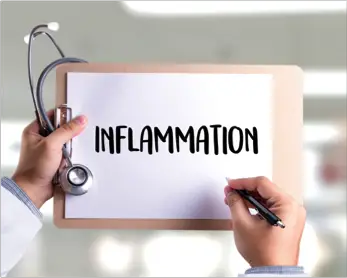Article reviewed and approved by Dr. Ibtissama Boukas, physician specializing in family medicine
CRP (or C-reactive protein) is widely used in medicine to determine the level of inflammation in the body. Even when you want to diagnose low back pain and other rheumatism, this measure can be very useful.
What is C-reactive protein (or CRP), and what to do with high C-reactive protein? Are there ways to improve this measurement naturally? When should you worry?
This popular article explains everything you need to know about C-reactive protein, and provides you with concrete strategies to reduce the level of inflammation in the body.
Definition
Before we talk about C-reactive protein, we need to understand some concepts related to inflammation.
Following a trauma, infection, or in the presence of several pathologies, an inflammatory reaction is triggered. Inflammation mediating molecules are then released. These are particularly responsible for the pain felt.
In the liver, a molecule is released in the presence of an inflammatory reaction. This is C-reactive protein. We can also measure its concentration in the blood.
This measurement is frequently used in medicine to determine the level of inflammation in the body. It can diagnose several acute and chronic inflammatory conditions, as well as several diseases.
For example, we can detect cardiovascular disorders and predict future myocardial infarction, stroke, or certain peripheral arterial diseases.
What is interesting with CRP is that it is released into the blood before the patient experiences any symptoms (like pain, fever or whatever). This can be interesting to establish an early diagnosis allowing a fast and effective care.
Now, what is the connection between C-reactive protein and back pain?
In several musculoskeletal pathologies (such as chronic low back pain), the inflammation seems to persist and cause disabling pain. It is to this extent that C-reactive protein may represent a useful marker in explaining symptoms.
On the other hand, an elevated C-reactive protein could lead to a diagnosis of ankylosing spondylitis, or rheumatoid arthritis. This is particularly useful, as the delay before diagnosing these inflammatory conditions can extend to up to 8 years.
Elevated C-Reactive Protein: When to Worry?
C-reactive protein is measured in milligrams per liter (mg/L). The results can be interpreted as follows:
Normals: Less than 10mg/L
High C-reactive protein : Equal to or greater than 10 mg/L
It should be understood that an elevated C-reactive protein measurement only indicates that there is an inflammatory reaction in the body, without identifying the exact cause. It can be a condition as trivial as an infection, as it can be a pathology as serious as cancer or a CVA (cerebrovascular accident). There is therefore no need to worry as soon as the CRP increases a little.
When he observes a high CRP measurement (generally from 6 mg/L and above), the doctor will then want to investigate further, in particular by carrying out other complementary tests to identify the source of the problem.
For example, if he suspects a inflammatory low back pain, it will relate your symptoms to the criteria specific to these conditions, as explained in the following infographic:
From a musculoskeletal perspective, what happens when C-reactive protein is elevated? :
- The pain threshold seems lower, which makes you more sensitive to pain.
- Function is reduced, and more day-to-day disability is observed in those with high C-reactive protein levels.
- Greater weakness has been observed in older people with high C-reactive protein levels.
In addition to musculoskeletal damage, here are some (more serious) conditions associated with an elevated CRP measurement:
- Lupus
- Arthritis (rheumatoid arthritis) and psoriasis
- Crohn's disease
- Myocardial infarction
- Cancer (carcinoma, lymphoma, etc.)
- Infections (fungal, bacterial, etc.)
- Sepsis
- Abscess
- Colitis
Causes
In addition to cardiovascular disease and rheumatism, there are several factors that can influence the level of C-reactive protein in the blood.
Indeed, this measurement is not stable over time, and varies according to several elements such as:
- Recent trauma
- Acute infection
- Cigarette
- Alcohol consumption
- overweight
- Condition associated with diabetes
- Poor sleep quality
- Stress, depression
- Poor diet
- Excess consumption of carbohydrates
- Poor magnesium intake
- Vitamin B6 and D deficiency
- Overtraining
C-reactive protein and back pain
We mentioned that low back pain frequently causes a painful inflammatory reaction. The same is true for conditions related to back pain such as ankylosing spondylitis.
On the other hand, it is important to note that the level of C-reactive protein is not proportional to pain. A high level of C-reactive protein does not mean that back pain will necessarily be amplified. This is because low back pain is multifactorial, and does not depend solely on an increased inflammatory reaction.
Moreover, a high level of C-reactive protein is not necessarily predictive of chronic pain. Indeed, several studies on herniated discs, sciatica or changes to modic did not establish a direct relationship between increased CRP and chronic low back pain.
In other words, even if your C-reactive protein level is increased after an episode of back pain, this does not mean that you will necessarily develop chronic pain in the future.
Elevated C-reactive protein: What to do?
If the doctor suspects any inflammatory condition, he will probably ask you for a blood test. He will pay particular attention to the C-reactive protein.
If he observes an elevated C-reactive protein, he can then push the clinical examination and radiological aimed at clarifying the diagnosis, and establishing the cause of your problem.
In addition to the diagnosis, we have seen that several factors can influence the level of C-reactive protein, and affect health. Since these are modifiable factors, we can put in place concrete strategies aimed at reducing the level of inflammation in the body as much as possible.
For example, certain medications like statins can lower the level of C-reactive protein.
Along with medication, a change in lifestyle and diet can make a huge difference in improving the body's level of C-reactive protein.
Indeed, studies have shown that yoga, or an 8-week exercise program, can reduce C-reactive protein levels. (Macphail et al 2015).
Food-wise, a low-carb diet (like the keto diet) can lower C-reactive protein levels. The same goes for a program focused on weight loss, more specifically fat loss (like anti-inflammatory diet).
Increasing consumption of fruits, vegetables and foods rich in antioxidants on a daily basis has also shown interesting results. Obviously, this must be done while respecting an adequate calorie intake, otherwise we would observe weight gain potentially harmful to health.
In terms of disease prevention (such as heart disease), it would be relevant to measure the C-reactive protein level regularly (via a blood test). Indeed, this measurement would be even more effective than the level of cholesterol in the blood in detecting cardiovascular disease.
Indeed, a blood CRP measurement below 3 mg/L indicates a mild to moderate risk, while a measurement above 3 mg/L indicates a high risk, and generally requires more drastic preventive and curative measures.
In addition to diagnosis and prevention, here are some practical applications related to C-reactive protein measurement:
- Evaluate the effectiveness of a drug or other treatment on a particular condition (CRP is expected to decrease as treatment is given)
- Determine if there are any complications after treatment or surgery
- Track an inflammatory disease over time
What about natural remedies?
Although they are not supported by solid scientific evidence, several natural products and grandmother's remedies are used to treat pain, especially for their anti-inflammatory power.
Here is a non-exhaustive list of plants and essential oils that are effective in controlling pain and inflammation. The products are available on the site Country. Use promo code LOMBAFIT15 if you wish to obtain one of the following products, or any remedy aimed at relieving your symptoms and improving your quality of life:
- Turmeric. Thanks to its antioxidant and anti-inflammatory powers very powerful, turmeric is one of the most used plants in a culinary and therapeutic context. The composition of turmeric is essentially made of essential oils, vitamins (B1, B2, B6, C, E, K) and trace elements. But it is to its composition rich in curcumin and curcuminoids that we owe them and calm skin of this spice.
- Ginger. In addition to the special flavor it brings to the kitchen and its aphrodisiac properties, ginger is a root well known for its anti-inflammatory powers. the gingerol gives it its anti-inflammatory action. It is an active component acting on the inflammatory pain related to chronic joint inflammatory diseases, including rheumatoid arthritis, lupus, rheumatic diseases, etc. It has been proven that this active element is also effective in acting on the inflammation linked to arthritis and sciatica. Ginger also has other benefits thanks to its high potassium content and its richness in trace elements (calcium, magnesium, phosphorus, sodium) and vitamins (provitamin and vitamin B9).
- Omega-3s. Omega-3s are polyunsaturated fatty acids that play a very important role in the functioning of our body. They are provided by food in three natural forms: docosahexaenoic acid (DHA), alpha linolenic acid (ALA) and eicosapentaenoic acid (EPA). Beyond their action on the brain and the cardiovascular system, omega-3s prove very effective against inflammation. Indeed, they have the ability to act on the inflammatory mechanisms in osteoarthritis by slowing down cartilage destruction, thus they reduce the intensity of osteoarthritis pain. Sciatica, being most often linked to an inflammation secondary to a herniated disc, it can also respond to omega-3 provided it is consumed regularly.
- Lemon eucalyptus. Eucalyptus is a plant most often used in the form of herbal tea or essential oil. She would have anti-inflammatory effects which give it the ability to act on the bone and joint pain in general and the pain of sciatica in particular.
- wintergreen. Wintergreen is a shrub from which a very interesting essential oil is extracted. It is one of the most used essential oils in aromatherapy. This oil extracted from the shrub bearing the same name, is used in massage to relieve sciatica and act like a analgesic. Indeed, it provides a heating effect thanks to its ability toactivate blood circulation locally.
Resources
Conclusion
C-reactive protein (CRP) is often analyzed during blood tests, especially if an acute or chronic inflammatory condition is suspected.
When elevated, it can indicate an inflammatory state of the body. High C-reactive protein comes from different causes, for example a inflammatory low back pain.
Elevated CRP has been observed to be associated with reduced pain thresholds, weakness, and decreased function. This could contribute to the development of chronic low back pain in some cases, although this measure is not predictive of chronic back pain.
An adjustment in lifestyle and diet can notably reduce the level of CRP.
Good recovery !





